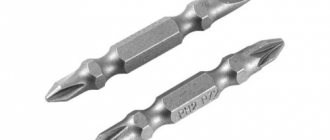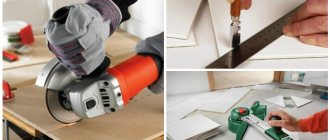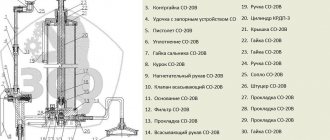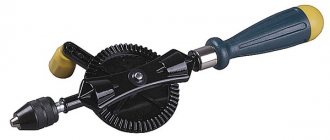To make my life easier and do a lot of household chores faster, I had to buy a screwdriver. But there is no expected effect: the mass of unknown buttons puts you in a stupor and you are afraid to turn it on. The reason for this is the banal inability to use a screwdriver. This is a fairly common problem among inexperienced craftsmen.
But there is a way out, after reading this article, which will explain better than standard instructions how to work with a screwdriver correctly.
Design and purpose of power tools
A screwdriver is used to tighten and unscrew various fasteners. The tool can cut threads and drill. It greatly facilitates and speeds up the work. Screwdrivers are used in everyday life, construction, furniture assembly, in auto repair shops, anywhere where you need to work with a large number of fasteners.
The screwdriver can be cordless or corded
Main elements of a screwdriver:
- Cartridge.
- Torque control clutch.
- Speed shifter.
- Motor in the screwdriver housing.
- The gearbox is enclosed in the tool body.
- Reverse switch.
- Power button.
- The handle is rubberized to prevent slipping.
- Battery.
- Power cord.
Screwdrivers are powered by batteries or mains.
Using a screwdriver at home
A screwdriver at home can be used everywhere, since modern devices in everyday life can easily replace a drill, screwdriver, and even a grinder when used infrequently. This requires special attachments, which can be purchased at many hardware stores.
Almost any job involving assembly/disassembly or installation of fasteners is speeded up several times when using a cordless screwdriver rather than a hand tool.
How to work with attachments
Screwdrivers have different cartridges. Let's look at how to change the nozzle in all types.
- quick-release chuck. There are single-coupling and double-coupling types. Installed most often. To open the jaws and remove the old bit, rotate the front clutch counterclockwise. Insert a new bit and screw the coupling back on;
Spirit coupling chuck - hexagonal chuck with magnet. The nozzle is simply inserted and pulled out;
Replacing the bit in a hex chuck - snap clamp.
Found in pneumatic screwdrivers. The nozzle is inserted and snapped into place. To remove it, you need to pull the bit while holding the head of the clamp. You need to hold the head to remove the bit
Rotational speed
To adjust the rotation speed, the device has a switch. It is usually located on top of the drill. It can be used to speed up the drill or slow it down. When set to number 1, it will spin slower. This position is suitable for:
- drilling deep holes of large diameter;
- screwing in difficult screws;
- loosening screws when unscrewing them from hard wood.
In position 2, the drill force is less, but its speed is higher. It is especially suitable for lightly loosening screws or for drilling shallow holes of small diameter.
ATTENTION!!!
To avoid damaging the switch, do not operate it until the tool has come to a complete stop.
How to use a screwdriver: useful operating tips
After purchasing a screwdriver, follow simple recommendations regarding use. And then the tool will work for a long time and efficiently:
- Before connecting and removing the battery, turn off the screwdriver;
- do not allow the instrument to overheat, take breaks;
- adjust the torque control clutch correctly;
- after using high speeds, set the minimum speed and idle the engine for several minutes to cool it down;
- Check the cable of the mains screwdriver, and the power cord of the charger for the battery. If a tool or charger periodically loses power, the wire must be replaced;
- Do not use the screwdriver in rain or snow. In humid environments, you can only work under a canopy.
Tool kit
Typically, such a tool is sold in special cases, where each part has its own place.
The drill/driver itself consists of a main tool and a removable battery, which is recharged from a household electrical outlet.
For charging, a special charger is used that comes with the set.
How to regulate speed and force
The rotation speed is changed by a switch located on the screwdriver body. High speed is used for large bolts and screws, as well as for drilling, if such a function is present.
Speed shifter
Many models have a force limiting clutch. Its presence in a power tool can be determined by a rotating ring with numbers. Some users do not understand the meaning of the clutch and do not touch it. Using a ratchet, you can adjust the depth of screwing in the screw. If the material is too soft, the head of the fastener is easily recessed and can pass right through. When using small fasteners, very high torque can destroy it. The ratchet prevents the slots of the screws from being cut off and the screwdriver bits from wearing out. To determine the desired value on the adjusting ring, make several passes, starting with the minimum. For drilling mode, maximum torque is used. But only if such a function is available.
Force limit clutch
The start button also regulates the rotation speed, but no more than that set by the switch. Let's say you set the switch to the first speed, which is stated to be up to 800 rpm. Pressing the trigger as hard as possible will not increase the speed. And the torque in maximum mode will be low, that is, you will not be able to tighten large screws and drill. And if you set the switch to maximum speed, you will be able to drill and the speed will be much higher.
Adjust speed, torque and reverse when the tool is off.
Terms of use
The answer to the question of how to use a screwdriver is quite simple; the main thing is to carefully follow the operating instructions, especially in the first stages of mastering a new tool.
Battery
The battery must be stored in a protective case at all times. It is best to put away the charger and metal objects to avoid shorting the opposite contacts and causing it to fail.
The battery is inserted simply - just install it in the corresponding groove at the bottom of the screwdriver handle and insert it until it clicks. To remove it, simultaneously press the buttons on both sides of the battery and remove it.
How to secure a bit or drill
It is necessary to place the rear part of the nozzle in the middle between the cams that clamp it. After this, hold the screwdriver sleeve with one hand and turn it on with the other, this will tighten the jaws and secure the bit or drill inside.
To remove the bit, the mechanism is similar, only you need to switch the screwdriver to reverse rotation mode and remove the attachment.
Drilling mode
Depending on what kind of fastener is used and what material it is screwed into, the force that the screwdriver applies to the head of the fastener varies. On top there is a switch with different numbers that indicate the force in Newtons.
For beginners, it can be difficult to immediately choose the right mode, for example:
- 6-8 N is enough to tighten a screw into wood
- for thick screws for metal at least 12 N
Screwing in and out of fasteners
Initially, the instrument is in a neutral position. The mode switch is usually located near the power button.
The switch may look different, but it has the same principle - it can include reverse (rotation in the opposite direction), neutral and clockwise rotation.
Important! When tightening and unscrewing, you should hold the screwdriver correctly.
It should be located perpendicular to the plane of the material being worked with. To tighten the screws, apply a little force so that the device can enter the material. When using it instead of an electric screwdriver, it is better, on the contrary, to do everything carefully without pressing hard to avoid unnecessary damage.
Source: www.youtube.com/watch?v=Ndttua5k4Tc
Care and storage
- regularly disassemble and clean the internal elements of the screwdriver from carbon deposits, dust and dirt;
- If unstable operation occurs, carry out diagnostics. Check the wear of the brushes so that you do not have to change the motor armature;
- Do not leave the instrument in areas with high humidity or under the sun. The same goes for the battery;
- Do not keep the battery near keys, coins or other short metal objects. In case of accidental contact with the poles, the battery will short circuit. As a result, a fire may occur;
- At the end of the working day, take a clean rag and wipe the instrument. The cloth can be slightly moistened with water without using detergents;
- The screwdriver should be stored in a dry environment with positive temperatures. Use a case or other packaging to prevent the instrument from becoming covered in dust.
Operate a screwdriver, observing safety precautions and the rules described in the instructions. Choose the right equipment. And then the tool will serve you for a long time.
Security measures
There is a list of tips for the safe operation of a screwdriver, following which you will be able to prolong its life and prevent malfunctions:
- start work only after making all the settings and inserting the necessary attachments;
- it is important to avoid getting inside: liquids, construction dust, shavings, sand;
- the room where work is carried out must be well lit;
- if the connection is made directly from electricity, you need to be sure that there are no voltage drops and that the electricity is supplied stably;
- The cartridge must be periodically lubricated and cleaned of any contaminants that have fallen on it;
- touching grounded objects with a working tool is unacceptable;
- For dummies who are using a screwdriver for the first time, it is useful to know that according to safety regulations, you should wear protective gloves and work clothes.
Classification
In its shape, the equipment resembles an oblong metal hexagon, which is fixed at one end in the unit’s cartridge. It is the type of holder that determines how to remove the attachment from the screwdriver. Using another tip, the user screws in screws and self-tapping screws. The type of base determines what type of fastening element the model is intended for.
Bits are conventionally classified into 3 categories:
- Basics . They have a cross-shaped working part. They are divided into spline, hexagonal, tetrahedral and sprocket.
- Combined . A specific type of fastener can be secured to each side of the nozzle. They produce options with different shank sizes and shapes.
- Special or highly specialized . Designed to perform specific tasks, therefore they are rarely used, sold individually.
The choice of equipment is facilitated by markings, on which the shape of the working part is indicated in letters, and the thickness of the rod is indicated in numbers.
Nozzles are made of hard and soft metals. According to the type of material, bits are distinguished from chromium, vanadium and molybdenum (two options are combined), as well as silicon-fire sinter. Steel samples are also available for sale, but their price is very high. Due to their short service life, purchasing such models is considered unprofitable.
Battery charging procedure
It is necessary to insert the battery into the device, observing the polarity (the corresponding “+” and “-” signs are placed on both the battery and the device), i.e. a plus is combined with a plus, and a minus is combined with a minus.
A glowing red diode on the device panel indicates that the charging process is in progress. This procedure lasts from 3 to 5 hours.
The rechargeable battery is protected from overcharging, so it can be left in the device for a longer period of time, but not more than 24 hours.
During charging, the battery and the device itself may become warm, but this does not indicate a malfunction.
Non-traditional use cases
In addition to its direct purpose, an electric screwdriver is used to perform various non-traditional operations. These include the following types of work:
- polishing the car and its headlights;
- mixing small volumes of various building mixtures and paints;
- drilling holes in ice (for this purpose the tool is equipped with a special attachment - a drill);
- binding of reinforcement;
- thread cutting;
- mowing the grass (for this purpose, convert the device into a trimmer or lawn mower, or simply insert an attachment with blades into the cartridge);
- chopping soft grass or thin branches (for this, a garden shredder is created based on a drill-driver);
- surface grinding;
- cutting materials;
- twisting of wires.
This is far from a complete list of non-traditional work performed using battery-powered or corded models of electric screwdrivers. Inventive thought does not stand still. Almost every specialist has options for work that is atypical for this power tool.
Using a screwdriver, you can return your car to its original color and shine. To polish a car, use the following types of attachments:
- leather or fabric circles, with their help they perform initial cleaning of surfaces;
- felt - they are used for initial processing and final polishing (nozzles made from sheepskin are suitable);
- foam rubber.
Polishing pastes and polishes are also used along with the equipment. They come in these types:
- silicone;
- abrasive;
- non-abrasive.
Using similar means, headlights are polished.
The quality of the achieved result is determined by the correct combination of attachments with polishing agents, as well as the accuracy and skill of performing the work.
Knitting reinforcing bars using steel wire is very common in the construction industry during the construction of reinforced concrete (monolithic) structures, for example, foundations and houses. Even if there is only a small amount of work to be done, working with a hand hook or pliers is quite unproductive. A cordless or corded electric screwdriver equipped with a hook attachment will help you knit reinforcement much faster. In this case, the power indicator of the tool is not particularly important.
Twisting the cut ends of wires, for example in junction boxes, is also a fairly routine job. You can speed up the process by using a screwdriver with a special attachment. How twisting is done is shown in the video below:
Why does a drill bit fall out of a screwdriver?
There are several reasons why drill bits may fall out of a screwdriver. Most often, the problem occurs due to an insufficiently tightened cartridge. In this case, the bit will not be fully clamped and, due to the increased load, the tightening will weaken. The drill falls out of the chuck.
In cases where the screwdriver has a keyed chuck, there is an increased likelihood that the master may not clamp the bit correctly. It is also worth considering that the cartridge has holes. During the tightening process, do not install the key in one hole and pull it all the way. The bit should be tightened evenly to prevent the chuck from unwinding. In this case, you will need to insert the key in turn into each of the recesses.
Often during operation the cartridge may jam. This causes the drill to fall out. In this case, experts recommend lubricating it with VD-40 liquid. The problem also occurs when dust/dirt gets on one of the elements of the tool.
A failed chuck causes the drill to fall out when working with a screwdriver. In such a situation, you will need to replace the worn part.
What to do if the bit gets stuck
Craftsmen often have a question about how to remove a bit from a screwdriver if it is jammed. It can get stuck in any type of cartridge for the following reasons:
- accumulation of a large amount of debris, scale under the figured frequent cams;
- fixation in the holder of equipment whose size is larger than permissible;
- poor quality material or nozzle overheating.
If such situations occur, the tool will not work. There are several ways to help remove a stuck element yourself, but if you do not have the necessary knowledge, it is better to solve the problem in a service center.
Experts recommend pulling out a drill or bit only after thoroughly lubricating the chuck with WD-40 . In this case, the element must be removed, and then lubricant must be poured until it flows over all the cams. After 15 min. The holder of the equipment is clamped in a vice, the jaws are tapped with a hammer (preferably a rubber one), and a cloth or wooden strip is placed under it. When the grip of the cams loosens, the nozzle will be easily unscrewed.
If it is not possible to achieve a positive result, then the cartridge is heated with a hairdryer.
Sometimes craftsmen use adjustable wrenches to remove equipment. One clamps the cartridge, and the other carefully unscrews its upper part. The use of soft, thin, but dense gaskets allows you to avoid damage to parts.
Types of cartridges for screwdrivers
There are several types of screwdriver chucks. Below you can find out more about each of them.
Key tooth chuck
To fix the drill in the gear chuck, the master will need to use a special key. As a rule, fastening is carried out by 3 “cams”, which are located symmetrically around the longitudinal axis of the spindle. The only disadvantage of such a chuck is the high risk of losing the key, without which it will be difficult to replace drills.
Keyless chuck
You can secure the drill in the quick-release chuck using your hand. Screwdrivers with single-sleeve and double-sleeve chucks are available for sale. The former are easy to use, while the manufacturer equips the latter with a pair of rotating rings (clamping and loosening). The main advantage of quick-release chucks is the ability to quickly replace drills. The quality of the clamp is similar to the key type, however, experts recommend giving preference to gear chucks when working with hard material under high loads.










